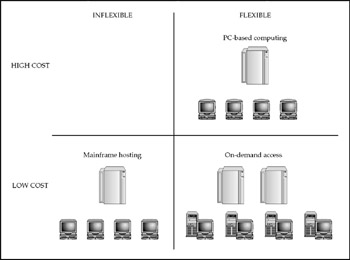ON-DEMAND ACCESS
| | ||
| | ||
| | ||
The Citrix Access Platform addresses the broad access area of on-demand access. This book focuses on the Citrix Access Suite, which specifically is geared toward optimizing the client/server and desktop-based application environment. The primary economic advantage of utilizing the Citrix Access Suite is the ability of the Citrix Presentation Server component to virtualize applications.
Application Virtualization
Instead of deploying, managing, updating, and securing a vast array of heterogeneous clients for every user , a single instance of the application is installed on a "presentation server" that is deployed in the data center. This server "virtualizes" application delivery by passing only screen pixels, keystrokes, and mouse movements over the wire instead of actual data. This process is transparent to end users, who have the same experience as if they were using each application locally, while IT administrators have a far more cost-effective , easy-to-manage, and secure method for providing access to these centralized applications.
Through virtualization, presentation services increase access speed, application performance, and network security and reduce network bandwidth consumption by eliminating the traditional requirement of transferring application data over the network.
Mainframe Model Similarities
In an enterprise implementation of Microsoft Windows 2003 Terminal Services and Citrix Presentation Server, most applications execute at one or more central data centers rather than on individual PCs. This entails a paradigm shift back to mainframe methodologies, procedures, and discipline, while still utilizing technology and environmental aspects unique to the PC world. It requires a much more resilient, reliable, and redundant network infrastructure than in a conventional client/server WAN. Myriad decisions must be made regarding building this infrastructure as well as several ancillary items such as choosing the right terminals, prioritizing WAN traffic, consolidating storage, enabling redundancy, and migrating from legacy systems.
An on-demand access platform has other similarities with the mainframe model of computing. For example, IT control of the desktop and application standards, reduced infrastructure costs, and much lower staffing requirements are attributes shared with the mainframe environment. Unlike with the mainframe model, though, users do not have to wait six months in a MIS queue in order to have IT produce a report for them. Instead, they can create it themselves in minutes by using Excel or any application to which IT gives them access.
On-demand access thus combines the best of both the mainframe and PC worlds . It incorporates the inexpensive desktop-computing cost structure of the mainframe model while allowing users the flexibility and versatility they are used to having with their PCs. The matrix in Figure 1-1 compares on-demand access with both mainframe and PC-based computing with respect to cost and flexibility.

Figure 1-1: On-demand access combines flexibility with low costs.
Benefits of an Enterprise Deployment of the Citrix Access Suite
On-demand access utilizing Microsoft Terminal Server and the Citrix Access Suite is reshaping corporate computing by driving costs out of IT. A 2003 Gartner study of 23 Citrix customers across five continents determined that the average risk-adjusted payback for the firms participating in the study occurred within 7.5 months of deploying the Citrix access platform on an enterprise scale. And while the economic justification for Citrix alone is compelling, many organizations are transitioning to this architecture primarily to take advantage of other strategic benefits such as improved security, enhanced disaster recovery/business continuance, faster time to market, increased productivity, universal information access, and faster organizational growth.
On-Demand Access Concerns
An on-demand access environment enables organizations to deliver software as a utility-like (pay only for what you use) service. (We discuss how an IT department can create a utility-like internal subscription billing model in Appendix C.) In this environment, building a robust, reliable, and scalable architecture is essential. The data centers must operate similarly to mainframe shops , with control over changes, limited access, and well-defined policies and procedures such as rigorous offline testing of all new applications before their introduction into the production environment.
But despite the continuing huge success of Citrix Access Suite and the overwhelming advantages of on-demand access, it is still a long way away from being universally accepted as the corporate computing standard. The reason is that organizations tend to move slowly in adopting new technology paradigms . A myriad of educational, historical, cultural, and of course, political factors influence an organization's decision of whether or not to implement an access platform paradigm. Different departments, for example, may control their own budgets and have their own IT staffs. They may resist ceding computing control to a centralized corporate IT department. Users who distrust a network's reliability because of a history of frequent downtime are going to be extremely reluctant to place all of their computing eggs in the IT department's basket .
EAN: 2147483647
Pages: 137